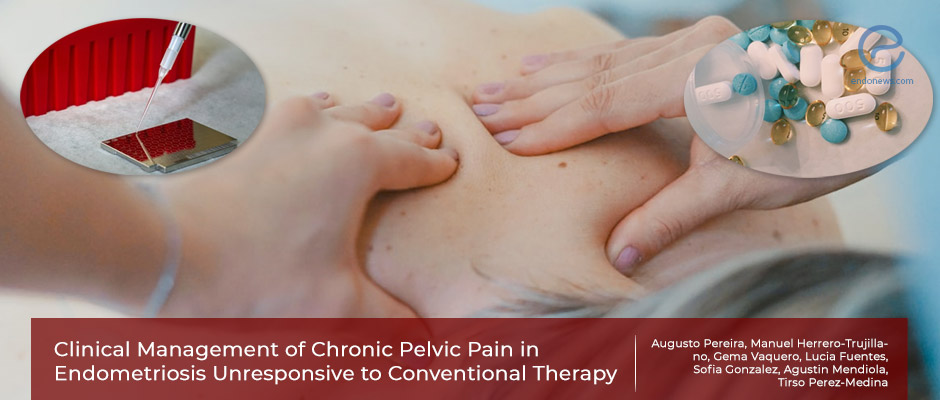From Spain: execution for endometriosis and chronic pelvic pain unresponsive to conventional therapies
Feb 8, 2022
Knowing the location and type of pain for each patient may be the key to improving chronic pelvic pain.
Key Points
Importance:
- Unresponsiveness to conventional treatments for chronic pelvic pain even after surgical removal of endometriosis is common, central sensitization increases the probability of failure.
- There is a need for the perception of the underlining mechanism of endometriosis induced-pelvic pain for better management.
Highlights:
- Up to 70% partial recovery can be achieved when appropriate treatment is given on an individual basis to endometriotic patients who had failed to respond to conventional therapies.
What's done here:
- The clinical data from 46 women unresponsive to conventional therapies for endometriosis and pain for six months were reviewed retrospectively.
- Based on their history and examination clinicians divided all patients into neuropathic or nociceptive pain (nociceptive further divided into visceral or somatic).
- Neurologic examination, pelvic girdle, and pelvic floor muscle examination findings were deducted from a previous study of the authors.
- The demographic data, full history, comorbidities, neighboring organ pain/duration, along with the characteristics, localization, irradiation, the intensity of pain, treatment, and outcomes were evaluated.
- Treatment was based on therapy based on the protocols for unresponsive patients used at the authors' hospital, as followings:
- Myofascial pelvic pain syndrome (somatic nociceptive) treatment 1 including physical therapy and trigger point injection
- Visceral nociceptive pain treatment with opioids combined with hypogastric plexus blockage
- Neuromodulators for neuropathic pain and peripheral nerve blocks.
- For both neuropathic and nociceptive pain, pulsed radiofrequency with inferior hypogastric block.
Key Results:
- The most common pain location was abdominal (at the hypogastrium, and/or iliac fossa).
- Sexual intercourse pain and rectal pain were found in more than half of the unresponsive patients, and urologic pain was reported in more than one-third.
- Almost all the patients (98%) had nociceptive and %70 had neuropathic pain.
- More than 40% of patients responded to neuromodulators.
- Combined therapies for myofascial pain syndrome along with treatment of visceral pain treatment with hypogastric plexus blocks, proved beneficial.
- More than 50% of median pain relief was achieved within about 4 months of median follow-up.
Lay Summary
The current conventional therapy for chronic pelvic pain for endometriosis is defined as either hormonal or non-hormonal medical treatment starting with combined oral contraceptives progestins or dienogest, and then gonadotropin-releasing hormone analogs and/or surgery. Although conventional therapies usually are successful, still one-fourth to one-third of the patients do not achieve pain relief, probably either due to intolerance or contraindications to the therapy.
Pereira et al. from Puerta de Hierro University Hospital, Spain, conducted a retrospective study to evaluate the benefit of identifying the pain type and localization before starting the appropriate treatment for chronic pelvic pain in women with endometriosis in non-responsive patients to plan a successful further treatment. The results were recently published in the Journal of Personalized Medicine.
The study population was composed of 46 endometriotic women who failed to respond to conventional chronic pelvic pain treatments in their clinic. The pain type of one-forth of the study group was pure nociceptive pain which was treated by muscle relaxants, physiotherapy, trigger point injection, and botulinum toxin inside pelvic muscles For visceral pains, minor or major opioids were used along with hypogastric nerve blockades. On the other hand, neuropathic pain was treated differently.
Almost all the patients (98%) had nociceptive and %70 had neuropathic pain, and more than 40% of patients responded to neuromodulators. furthermore, combined therapies for myofascial pain syndrome along with visceral pain treatment by hypogastric plexus blocks proved beneficial. Finally, pain relief in more than half of the patients was achieved within about 4 months of median follow-up.
The authors underlined the necessity of multidisciplinary and multimodal focusing on patients' history and examination for unresponsive patients, in order to create an early effective treatment, and further stressed the obligation for a better understanding of the mechanisms underlying endometriosis-induced pain.
Research Source: https://pubmed.ncbi.nlm.nih.gov/35055416/
chronic pelvic pain conventional therapy botulinum toxin diazepam amitryptyline hypogastric plexus blockade physiotherapy pulsed radiofrequency non-responders endometriosis.

